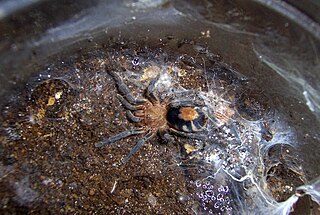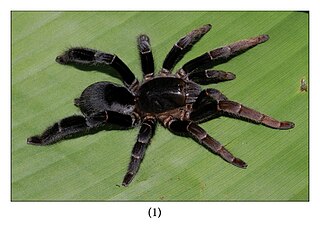
Tarantulas comprise a group of large and often hairy spiders of the family Theraphosidae. As of December 2023, 1,100 species have been identified, with 166 genera. The term "tarantula" is usually used to describe members of the family Theraphosidae, although many other members of the same infraorder (Mygalomorphae) are commonly referred to as "tarantulas" or "false tarantulas". Some of the more common species have become popular in the exotic pet trade. Many New World species kept as pets have setae known as urticating hairs that can cause irritation to the skin, and in extreme cases, cause damage to the eyes.

Aphonopelma moderatum is a species of spider in the family Theraphosidae, found in United States, in the state of Texas. Commonly called the Rio Grande Gold Tarantula as they are found in the Rio Grande Valley of Texas.

Ephebopus cyanognathus, known as the blue fang tarantula, is a species of tarantula. It is endemic to French Guiana. It was first described by Rick C. West and Samuel D Marshall in 2000, and is somewhat commonly kept as pets. As it common name may suggest, they have magnificent blue chelicerae, cyano meaning blue and gnathus meaning jaw. This tarantula is a burrowing spider, though spiderlings of this species have been observed to be semi-arboreal.

Aphonopelma bicoloratum, is a species of tarantula found in Mexico. As its common name aptly states it is found in Mexico, and was first described by Ronny Struchen, D. Brändle and Gunter Schmidt in 1996. It is named after the Latin word bicoloratum, meaning bicolored.

Encyocratella is a monotypic genus of Tanzanian tarantulas containing the single species, Encyocratella olivacea, also known as the Tanzanian black and olive baboon spider. It was first described by Embrik Strand in 1907, and is found in Tanzania.

Caribena laeta, otherwise known as the Puerto Rican pink toe tarantula, is a species of spider in the family Theraphosidae, found in the US Virgin Islands, Puerto Rico, and Cuba, the last dubiously according to Caroline Fukushima and Rogério Bertani in 2017. It was first described by Carl Ludwig Koch in 1842 under the name Mygale laeta.

Chilobrachys fimbriatus, commonly known as the Indian Violet Earth Tiger Tarantula usually shortened to Indian Violet Tarantula, is a species of spider of the genus Chilobrachys. It is endemic to India, and was first described by Reginald Innes Pocock in 1899.

Thrixopelma ockerti, commonly known as the Peruvian Flame Rump or Flame Rump Tree Spider, is a species of tarantula and the type species of the genus Thrixopelma. It is endemic to Peru and was first described by Gunter Schmidt in 1994. It is named ockerti after the collector Roland Ockert.

Phormictopus auratus, commonly known as the Cuban bronze tarantula, is a species of tarantula endemic to Cuba. It is found in the provinces of Camagüey, Las Tunas and Holguín. It was first described by David Ortiz and Rogério Bertani in 2005, and was named after golden hairs found in this species, auratus meaning golden in Latin.

Ceratogyrus marshalli, also known as Straight Horned Baboon or Great Horned Baboon Tarantula, is a species of tarantula from the genus Ceratogyrus. It is found in Zimbabwe and Mozambique. It was first described by Reginald Innes Pocock in 1897, as half of the Ceratogyrus genus, they own a impressive horn in the carapace.
Ornithoctonus aureotibialis is a tarantula species in the Ornithoctonus genus, it was first described by Volker von Wirth and Boris F. Striffler in 2005. It is named for the Latin, aureus being "golden" and tibia. Because of the gold or orange coloured line of hair in the tibiae of the legs in subadult and adult females and subadult males. Its common name is Thailand Golden Fringe, as the name may suggest it is found in Thailand, Myanmar and Malaysia. It is sometimes kept as a pet, and are captive bred.

Monocentropus balfouri is a tarantula in the Monocentropus genus, it was first described by Reginald Innes Pocock in 1897. This tarantula is also called Socotra Island Blue Baboon Tarantula, usually shortened to Blue Baboon Tarantula. This spider is named after its collector Isaac Bayley Balfour. It is found in Socotra Island, hence the common name. This tarantula is terrestrial and an opportunistic burrower. Like many tarantulas, M. balfouri can be kept as a pet, although it is not a beginner species.
Phrixotrichus scrofa is a tarantula spider, commonly known as the Chilean copper, Chilean pink burst or Chilean violet tarantula. It was first described by Juan Ignacio Molina in 1782. Its synonyms include Phrixotrichus auratus, Paraphysa scrofa, and possibly Phrixotrichus chilensis. It is native to Chile and Argentina, inhabiting mainly arid forests, and is kept as a pet somewhat commonly.
Acanthoscurria insubtilis also known as the Bolivian black velvet tarantula, is a spider which was first described by Eugène Simon in 1892. It is found in Bolivia, with some reports also stating in Brazil, though it is mainly in the Bolivian Rainforests.
Eucratoscelus pachypus also known as the Tanzania stout leg baboon tarantula or the stout leg tarantula, was first described by Gunter Schmidt and Volker von Wirth in 1990. It is found in Tanzania, hailing from arid parts, and is an obligate burrower.

Harpactira cafreriana otherwise known as the Cape copper baboon or amber baboontarantula spider was first described by Charles Athanase Walckenaer in 1837. It is found in South Africa, being terrestrial or semi-fossorial in nature.
Bonnetina minax also known as Mexican copperhead tarantula, is a tarantula which was first described by David Ortiz and Oscar F. Francke in 2017. It is found in Mexico, in the state of Michoacán, and is named after the Latin adjective "minax" that means menacing, as the red found in is carapace is usually aposematic coloration.

Cyriocosmus perezmilesi otherwise known as the Bolivian dwarf beauty tarantula is a spider which was first described by Radan Kaderka in 2007. It was named in honor of Dr. Fernando Pérez-Miles, and is a fossorial tarantula. As its common name aptly states it is found in Bolivia.

Lyrognathus giannisposatoi sometimes called the Sumatran stout leg tarantula is a tarantula which can be found in Mesuji Regency, Sumatra, Indonesia. It was first described by Steven C. Nunn, Rick C. West in 2013, and is named after Gianni Sposato, who helped with Selenocosmia material, and was of great help to the authors.
Murphyarachne is a monotypic genus of Peruvian tarantulas, with one species, Murphyarachne ymasumacae. It was first described by Sherwood and Gabriel in 2022. The genus is named after Frances Mary Murphy and John Alan Murphy for their contributions to arachnology, and the Greek term "arachne", which is the word for spider.













